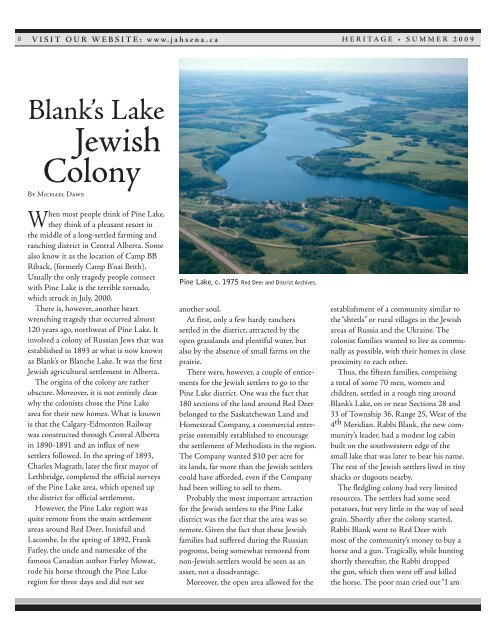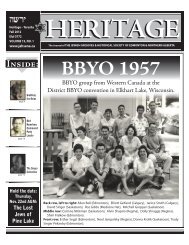Summer 2009 - Jewish Archives & Historical Society of Edmonton and
Summer 2009 - Jewish Archives & Historical Society of Edmonton and
Summer 2009 - Jewish Archives & Historical Society of Edmonton and
Create successful ePaper yourself
Turn your PDF publications into a flip-book with our unique Google optimized e-Paper software.
8 VIsIT OuR WEBsITE: www.jahsena.ca<br />
HERITAGE • summER <strong>2009</strong><br />
Blank’s lake<br />
<strong>Jewish</strong><br />
colony<br />
By Michael dawe<br />
When most people think <strong>of</strong> Pine lake,<br />
they think <strong>of</strong> a pleasant resort in<br />
the middle <strong>of</strong> a long-settled farming <strong>and</strong><br />
ranching district in central Alberta. Some<br />
also know it as the location <strong>of</strong> camp BB<br />
riback, (formerly camp B’nai Brith).<br />
Usually the only tragedy people connect<br />
with Pine lake is the terrible tornado,<br />
which struck in July, 2000.<br />
there is, however, another heart<br />
wrenching tragedy that occurred almost<br />
120 years ago, northwest <strong>of</strong> Pine lake. it<br />
involved a colony <strong>of</strong> russian Jews that was<br />
established in 1893 at what is now known<br />
as Blank’s or Blanche lake. it was the first<br />
<strong>Jewish</strong> agricultural settlement in Alberta.<br />
the origins <strong>of</strong> the colony are rather<br />
obscure. Moreover, it is not entirely clear<br />
why the colonists chose the Pine lake<br />
area for their new homes. What is known<br />
is that the calgary-edmonton railway<br />
was constructed through central Alberta<br />
in 1890-1891 <strong>and</strong> an influx <strong>of</strong> new<br />
settlers followed. in the spring <strong>of</strong> 1893,<br />
charles Magrath, later the first mayor <strong>of</strong><br />
lethbridge, completed the <strong>of</strong>ficial surveys<br />
<strong>of</strong> the Pine lake area, which opened up<br />
the district for <strong>of</strong>ficial settlement.<br />
However, the Pine lake region was<br />
quite remote from the main settlement<br />
areas around red deer, innisfail <strong>and</strong><br />
lacombe. in the spring <strong>of</strong> 1892, Frank<br />
Farley, the uncle <strong>and</strong> namesake <strong>of</strong> the<br />
famous canadian author Farley Mowat,<br />
rode his horse through the Pine lake<br />
region for three days <strong>and</strong> did not see<br />
Pine Lake, c. 1975 Red Deer <strong>and</strong> District <strong>Archives</strong>.<br />
another soul.<br />
At first, only a few hardy ranchers<br />
settled in the district, attracted by the<br />
open grassl<strong>and</strong>s <strong>and</strong> plentiful water, but<br />
also by the absence <strong>of</strong> small farms on the<br />
prairie.<br />
there were, however, a couple <strong>of</strong> enticements<br />
for the <strong>Jewish</strong> settlers to go to the<br />
Pine lake district. One was the fact that<br />
180 sections <strong>of</strong> the l<strong>and</strong> around red deer<br />
belonged to the Saskatchewan l<strong>and</strong> <strong>and</strong><br />
Homestead company, a commercial enterprise<br />
ostensibly established to encourage<br />
the settlement <strong>of</strong> Methodists in the region.<br />
the company wanted $10 per acre for<br />
its l<strong>and</strong>s, far more than the <strong>Jewish</strong> settlers<br />
could have afforded, even if the company<br />
had been willing to sell to them.<br />
Probably the most important attraction<br />
for the <strong>Jewish</strong> settlers to the Pine lake<br />
district was the fact that the area was so<br />
remote. given the fact that these <strong>Jewish</strong><br />
families had suffered during the russian<br />
pogroms, being somewhat removed from<br />
non-<strong>Jewish</strong> settlers would be seen as an<br />
asset, not a disadvantage.<br />
Moreover, the open area allowed for the<br />
establishment <strong>of</strong> a community similar to<br />
the “shtetls” or rural villages in the <strong>Jewish</strong><br />
areas <strong>of</strong> russia <strong>and</strong> the Ukraine. the<br />
colonist families wanted to live as communally<br />
as possible, with their homes in close<br />
proximity to each other.<br />
thus, the fifteen families, comprising<br />
a total <strong>of</strong> some 70 men, women <strong>and</strong><br />
children, settled in a rough ring around<br />
Blank’s lake, on or near Sections 28 <strong>and</strong><br />
33 <strong>of</strong> township 36, range 25, West <strong>of</strong> the<br />
4 th Meridian. rabbi Blank, the new community’s<br />
leader, had a modest log cabin<br />
built on the southwestern edge <strong>of</strong> the<br />
small lake that was later to bear his name.<br />
the rest <strong>of</strong> the <strong>Jewish</strong> settlers lived in tiny<br />
shacks or dugouts nearby.<br />
the fledgling colony had very limited<br />
resources. the settlers had some seed<br />
potatoes, but very little in the way <strong>of</strong> seed<br />
grain. Shortly after the colony started,<br />
rabbi Blank went to red deer with<br />
most <strong>of</strong> the community’s money to buy a<br />
horse <strong>and</strong> a gun. tragically, while hunting<br />
shortly thereafter, the rabbi dropped<br />
the gun, which then went <strong>of</strong>f <strong>and</strong> killed<br />
the horse. the poor man cried out “i am



